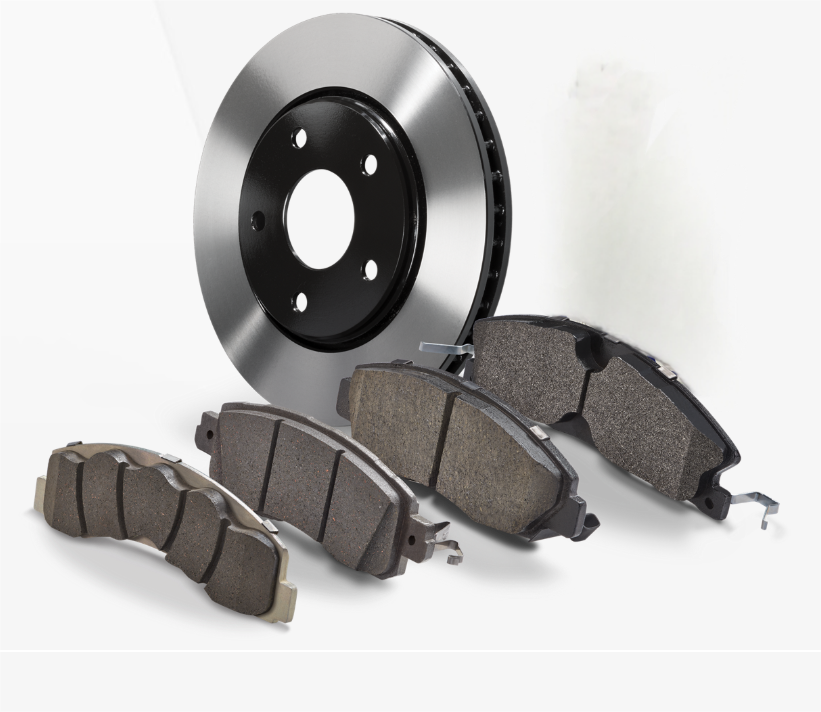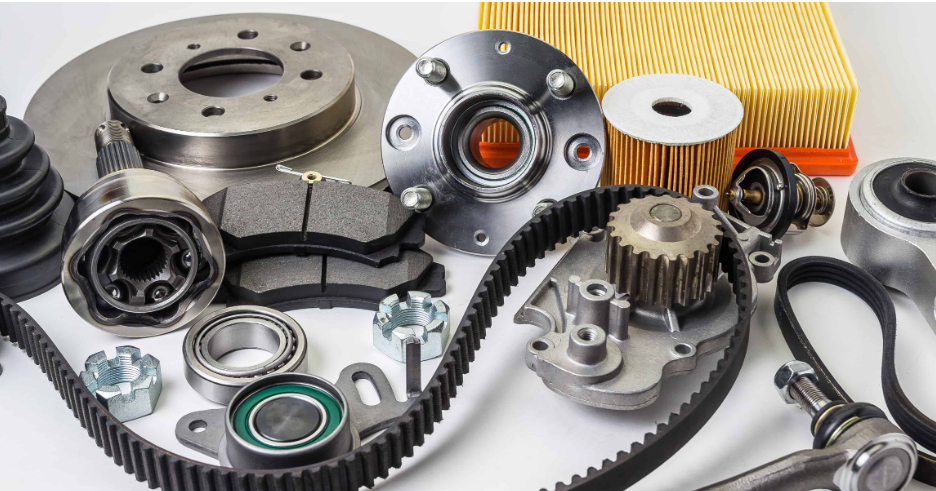How Brake Shoes Generate Friction to Stop Vehicles
The brake shoes are critical components in the drum brake system, considering that they generate friction to stop the car. When the driver depresses the brake pedal, a hydraulic force pushes the brake shoes, causing them to expand outward to the drum. They make contact with the drum, causing the desired friction that slows down and completely halts the vehicle. The shoes have a hardy lining material that is strong enough to resist high temperatures and offer good and constant braking performance, even in extreme circumstances. The significance of this material is vital in facilitating effective brake system functioning and safe driving.
Brake Shoes vs. Brake Pads: Key Differences in Function
Knowing the brake shoes and brake pads difference is crucial for the well-being of your vehicle’s braking system. Drum brake systems include brake shoes, whereas disc brake systems use brake pads. Brake shoe designs allow for more surface area on which friction can be generated, with certain advantages, when used on particular vehicle applications, especially heavy-duty ones. Brake pads, on the other hand, are easier to maintain and often claim better high-performance qualities, such as faster heat dissipation. When trying to decide which of the two to select, you need to take into account the vehicle application and performance requirements to get the maximum braking performance.
Why Drum Brakes Rely Heavily on Brake Shoes
Drum brakes have been used in a wide range of vehicles by virtue of their ability to supply good stopping power with the aid of good brake shoes. This dependence on brake shoes in drum brakes is in part because in some heavy-duty circumstances - towing, for example - drum brake systems have the ability to create more friction than a disc system. Also, the drum type of braking also allows for enhanced heat conduction, which allows the brakes to disperse heat better throughout the drum system. This feature provides better performance, especially under heavy braking with the drum brake being preferred system of many automobile manufacturers for certain vehicle types.
Common Symptoms of Worn Brake Shoes
Knowing when your brake shoes need replacing is essential to your safety and the performance of your vehicle. I can hear one of the shoes making a squeaking or squealing sound, usually meaning that the shoes are getting paper thin and need changing. If you notice loss of braking power, or an increased stopping distance, your brake shoes may be worn. Operations can spot check as well; scoring or visible damage on the shoes means that immediate action is required, to avoid further damage to the brake system.
How to Check Brake Shoe Wear at Home
Safety first When it comes to inspecting wear on brake shoes at home, there are some simple and safe steps that should be checked. In order to reach the break system you need to raise the vehicle safely and take off the wheel. Once inside, look over the brake shoes. Check for adequate thickness; if they are dangerously thin, it indicates that replacement is vital. One easy way is to measure the thickness of the lining using a ruler: If itâs less than 1/8 inch thick, itâs time to replace them. With periodic examination, some wear can be detected early to provide proper maintenance when required.
Understanding Brake Shoes Replacement Costs
Knowing how much to replace brake shoes is important for planning vehicle maintenance. Mostly usually between $100 – 300 per axle with a fair degree of difference depending on what vehicle you own. Some of the things affecting the cost include labor rates, the type of brake shoes, and whether the necessary parts must be replaced. As with many parts of a car, the wheel cylinders need regular attention and immediate repair can be a lot cheaper than the replacement of the system once it's had a chance to fail completely, so it's worth knowing the cost of replacement to go along with the overall cost of the car itself.
Comparing Organic, Semi-Metallic, and Ceramic Compositions
Between organic vs semi-metallic vs ceramic brake pads the type you select relies on performance considerations. Organic compounds, usually consisting of resins and fibers, offer smoother and quieter riding and are less aggressive on skid plates and drum surfaces, but wear more quickly, particularly under severe conditions, such as street/drag or off-road racing. On the other hand, semi-metallic brake shoes are constructed with a blend of metals and synthetic compounds providing better heat resistance and longer life, as well as more flexibility for different driving conditions. Finally, ceramic formulas have become popular because they produce less dust and perform well under both normal and high heat conditions, though they can also be more expensive.
Best Brake Shoe Materials for Heavy-Duty Trucks
The choice of the brake shoe material is crucial to the performance and safety of a heavy-duty truck. Semi metallic brakes shoes are preferred by most as they provide high heat resistance and great stopping power which is an important factor in vehicles running under high load and frequent stop. Material selection has a signifiant influence on the performance and safety of truck braking systems. Manufacturers and automotive specialists should be consulted in order to select the right brake shoe material for heavy duty applications as per requirements. Such experts can offer us advice according to our specific requirements and depending on the set up of the truck’s brake mechanism.
Heat Dissipation Challenges in High-Performance Use
Performance cars suffer a number of specific problems, notably in terms of heat dissipation, which may result in brake fade and suboptimal braking efficiency. These demands require friction material for brake shoes that are capable of handling high temperatures generated by harsh driving conditions or even racing conditions. The key is to map how these different materials act in terms of heat resistance and energy dissipation in order to prevent not only dangerous situations but also wear and tear to the braking system. The interactions of selected materials with environmental heat need to be further investigated to enhance the reliability and functionality of the brakes, especially in high-performance operations, as they have a direct influence on the braking reliability and on performance deterioration under stress conditions.
When to Replace Brake Shoes vs. Full System Overhauls
Knowing the difference between replacing brake shoes and doing a full brake system overhaul can be very important to cost and vehicle safety. It is common that if it is not perfect contact and if you also feel irregular wear and/or noises with the brakes, the problem could be just the shoes by themselves. If that is the case, only the shoes may need to be replaced. An inspection is important because regular inspections help you spot these signs early and before the damage calls for a much bigger repair. You don’t have to wait until you can’t move to bed a helping hand – start by investigating the causes behind minor noises and vibrations which could be a sign of a bigger systemic problem in the brake system!
Impact of Driving Habits on Brake Shoe Longevity
Brake shoe longevity depends greatly on driving habits. Aggressive driving practices, like quick starts and hard stops, can also substantially reduce the life of your brake shoes. By smoother driving methods the lifespan of brake shoes will extent by 25-50% (depending on how you drive). A clear knowledge of that connection of how one drives and the life of brake shoe is necessary for proper-economical care of cars. Driving habit influences brake shoe longevity, and maintaining a braking shoe can help extend the working life and cut long-term vehicle maintenance cost.
Integrating New Brake Shoes with Modern ABS Systems
New Brake Shoes must be compatible with ABS in modern vehicles. Proper integration of the new brake shoes with the ABS to guarantee the maximum braking power. It is of utmost importance installing the ABS acccording to the manufacturer specifications in order to guarantee the ABS proper performace. Failure of this integration may result in inadequate loss of activation and safety, as well as, increased risk during emergency stop. Correctly integrated brake systems will keep the car just as responsive and safe as it was designed to be, which means it's crucial that installation be accurate.
Table of Contents
- How Brake Shoes Generate Friction to Stop Vehicles
- Brake Shoes vs. Brake Pads: Key Differences in Function
- Why Drum Brakes Rely Heavily on Brake Shoes
- Common Symptoms of Worn Brake Shoes
- How to Check Brake Shoe Wear at Home
- Understanding Brake Shoes Replacement Costs
- Comparing Organic, Semi-Metallic, and Ceramic Compositions
- Best Brake Shoe Materials for Heavy-Duty Trucks
- Heat Dissipation Challenges in High-Performance Use
- When to Replace Brake Shoes vs. Full System Overhauls
- Impact of Driving Habits on Brake Shoe Longevity
- Integrating New Brake Shoes with Modern ABS Systems







